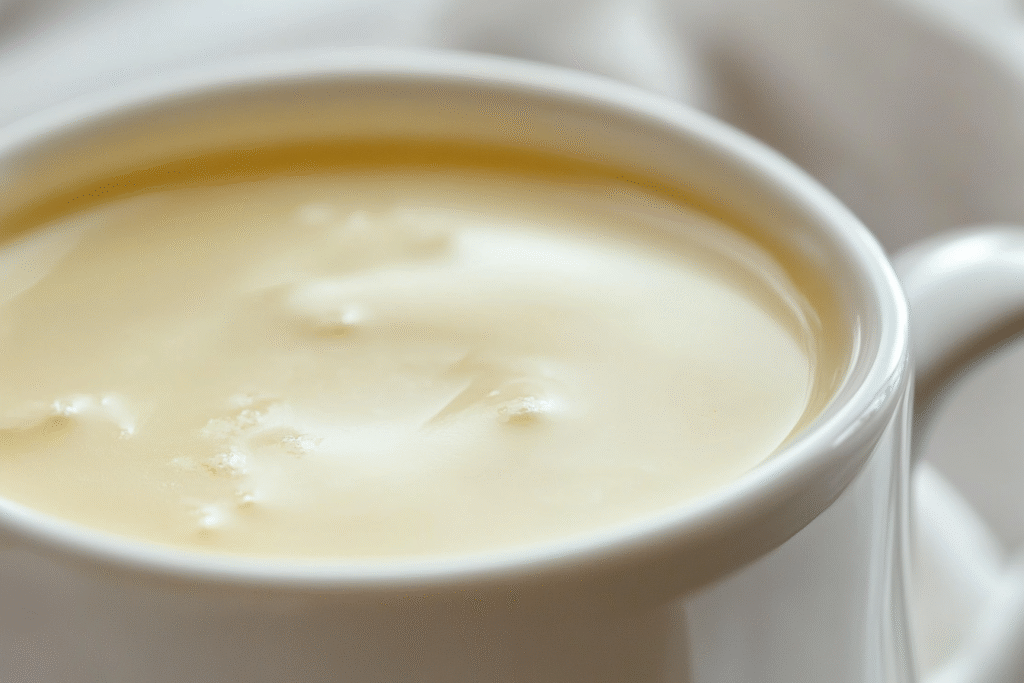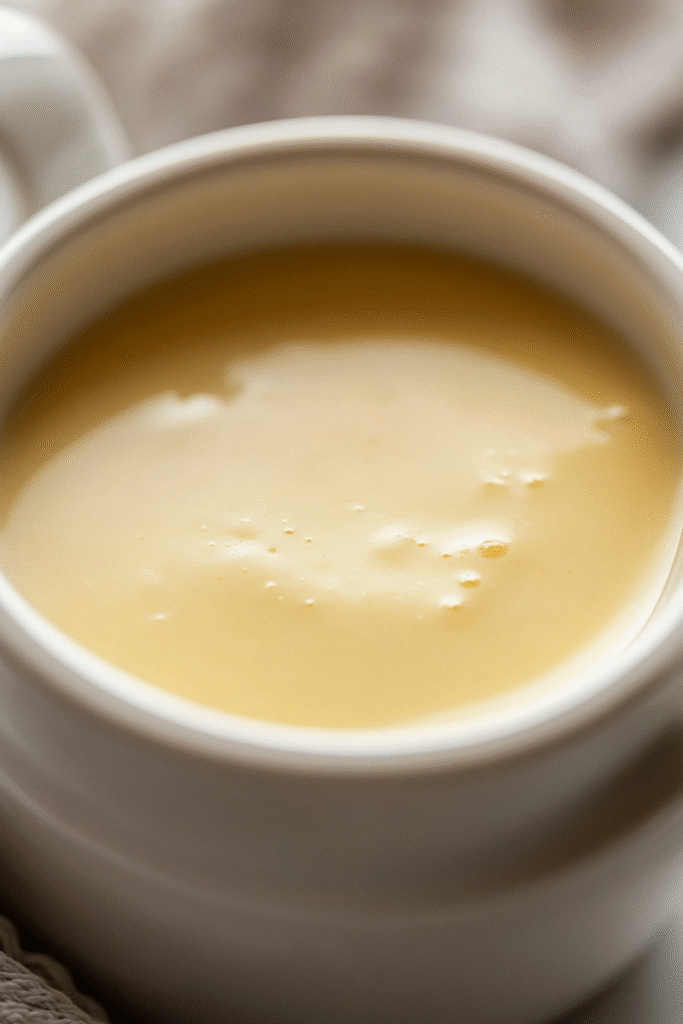The Enduring Charm of Homemade Custard
Classic Homemade Custard is the heart of many beloved desserts, offering a smooth, velvety texture and a gently sweet, creamy flavor that enhances everything from pies and crumbles to simple sponge cakes. Unlike instant custard or powdered mixes, homemade custard has a rich, natural taste and a luscious mouthfeel that elevates even the most humble desserts.
At its core, custard is a simple combination of egg yolks, milk (or cream), sugar, and often a touch of vanilla, gently cooked to form a silky sauce. The key to success is patience and attention—custard rewards careful heat management with its perfectly smooth texture and delicate sweetness.
This custard recipe is a pouring custard, perfect for serving warm or cold over desserts like apple crumble, treacle sponge, or fruit puddings. It’s a timeless dessert sauce that’s easy to master and infinitely better than anything from a packet.

Selecting the Best Ingredients for Homemade Custard
Dairy:
- Whole Milk: Provides the classic custard texture—light but creamy.
- Double Cream (Heavy Cream): For a richer, more indulgent custard, substitute part of the milk with cream.
- Full-Fat Only: Low-fat milk produces a thinner custard that can lack body.
Eggs:
- Fresh Egg Yolks: Essential for thickening the custard and providing richness.
- Room Temperature: They incorporate more smoothly into the hot milk.
Sugar:
- Caster Sugar (Superfine Sugar): Dissolves quickly and smoothly.
- Adjustable Sweetness: Can be slightly reduced if serving with very sweet desserts.
Flavoring:
- Vanilla Pod: Provides the most natural, fragrant flavor.
- Vanilla Extract or Paste: Good substitutes for convenience.

Recommended Equipment for Smooth Custard
- Heavy-Bottomed Saucepan: Ensures even heating and reduces the risk of scorching.
- Balloon Whisk: For constant stirring without scrambling the eggs.
- Heatproof Bowl: Useful for straining the custard if needed.
- Fine Mesh Sieve: Optional but recommended for ultra-smooth custard.
- Measuring Jug: Makes pouring over desserts easier.
Common Mistakes and How to Avoid Them
1. Cooking Too Quickly
Custard must be gently heated over low to medium heat. High heat risks curdling and creates a grainy texture.
2. Not Stirring Enough
Constant stirring is essential to prevent the custard from catching on the bottom of the pan and forming lumps.
3. Not Tempering the Eggs
Slowly adding hot milk to the egg mixture prevents the eggs from scrambling.
4. Overcooking
Custard should be thick enough to coat the back of a spoon but will continue to thicken slightly as it cools. If overheated, it can curdle.
Ingredient Swaps and Dietary Adjustments
- Dairy-Free: Use almond, oat, or coconut milk with plant-based cream, though texture will differ.
- Sugar Alternatives: Use maple syrup, honey, or coconut sugar for different flavor profiles.
- Gluten-Free: Naturally gluten-free, but always check labels on vanilla extracts.
Prep-Ahead and Time-Saving Tips
- Separate Eggs in Advance: Store yolks covered in the fridge until ready to use.
- Pre-Measure Ingredients: Helps avoid overcooking while measuring.
- Make Ahead: Custard can be made 1–2 days in advance and stored in the fridge. Reheat gently over low heat.
Flavor Variations and Pairing Ideas
- Cinnamon or Nutmeg: Infuse the milk for a spiced version.
- Chocolate Custard: Melt dark chocolate into the hot custard.
- Lemon Custard: Infuse with lemon zest for a citrus twist.
Perfect Pairings:
- Fruit crumbles, especially apple or rhubarb.
- Treacle sponge pudding.
- Jam roly-poly.
- Stewed berries or fresh strawberries.
- Simple pound cakes or Victoria sponge.
Classic Homemade Custard Recipe
Ingredients
- 500 ml (2 cups) whole milk
- 4 large egg yolks
- 2 tablespoons caster sugar (or to taste)
- 1 teaspoon vanilla extract or seeds from 1 vanilla pod
- Optional: 100 ml (1/2 cup) double cream for a richer custard
Instructions
Step 1: Heat the Milk
- In a heavy-bottomed saucepan, gently heat the milk (and cream if using) with the vanilla pod (or vanilla extract).
- Warm over medium heat until steaming but not boiling.
- Remove from heat and let sit for 5 minutes if using a vanilla pod to infuse.
Step 2: Whisk the Egg Yolks
- In a mixing bowl, whisk the egg yolks and sugar together until pale and slightly thickened.
Step 3: Temper the Eggs
- Slowly pour a little of the warm milk into the egg yolk mixture, whisking constantly to temper the eggs.
- Gradually add the rest of the milk while whisking.
Step 4: Cook the Custard
- Pour the mixture back into the saucepan.
- Cook over low heat, stirring constantly with a wooden spoon or spatula, ensuring you scrape the sides and bottom.
Step 5: Thicken
- Continue cooking for 6–8 minutes until the custard thickens enough to coat the back of a spoon.
- Run your finger across the back of the spoon—if the line holds, it’s ready.
Step 6: Strain and Serve
- Optional: Pour the custard through a fine mesh sieve into a clean jug for a perfectly smooth finish.
- Serve warm, or cool to room temperature and chill for a cold custard.
Storage and Reheating
- Refrigerator: Store cooled custard in an airtight container for up to 2 days.
- Reheating: Warm gently in a saucepan over low heat, stirring constantly. Do not boil.
- Freezing: Not recommended—custard may separate when thawed.
Troubleshooting Tips
- Custard Curdling: Can happen if overheated. If it starts to curdle, immediately remove from heat and whisk vigorously.
- Custard Too Thin: May need a few more minutes of gentle cooking.
- Custard Too Thick: Thin with a little warm milk, whisking well to incorporate.
Variations: Pouring Custard vs. Thick Custard
- Pouring Custard (Crème Anglaise): This recipe creates a smooth, pourable custard, perfect for desserts like crumbles and sponges.
- Thick Custard: For a set custard (like custard tarts), increase egg yolks and cook longer, or thicken with a little cornstarch.
Each version serves a distinct purpose but shares the same rich, comforting base.
Serving Suggestions
- With Desserts: Pour over apple crumble, sticky toffee pudding, or jam roly-poly.
- With Fresh Fruit: Drizzle over strawberries, raspberries, or baked apples.
- With Cakes: Perfect with Victoria sponge, lemon drizzle cake, or pound cake.
- As a Standalone Dessert: Serve chilled with a sprinkle of nutmeg.
Classic homemade custard pairs beautifully with warm desserts and adds a timeless touch to any sweet dish. For drinks, enjoy alongside tea, coffee, or a dessert wine like Moscato. Homemade custard is simple, elegant, and infinitely better than anything from a carton.
